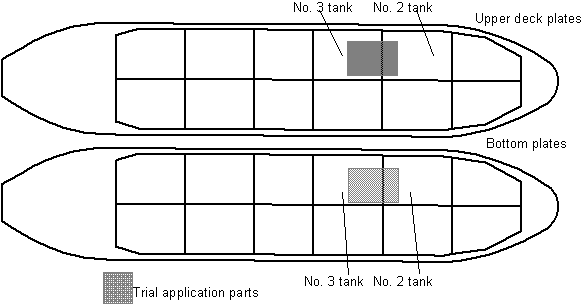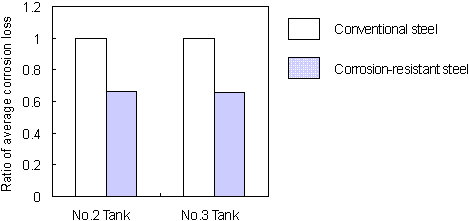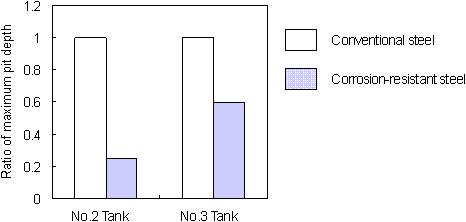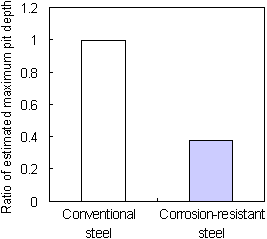SMICORE, High Corrosion-Resistant Steel Plate for Crude Oil Tanks in Oil Tankers Developed by Sumitomo Metals, Obtains World-First Confirmation of High Corrosion Resistance in Both Upper Decks and Bottoms of Tanks in Actual Vessel Trial
2008.12.25
- Sumitomo Metal Industries, Ltd.
Sumitomo Metal Industries, Ltd. (Sumitomo Metals) developed SMICORE (SMI Crude Oil Corrosion Resistant Steel), a steel plate with enhanced corrosion resistance for the upper decks and bottoms of crude oil tanks in oil tankers, which are exposed to severe corrosive conditions, in 2004. Recently, after the completion of a corrosion resistance trial on an actual vessel over a period of approximately two years and nine months, it was confirmed for the first time in the world that SMICORE has higher corrosion resistance than conventional steel in both upper decks and bottoms.
1. Background to Development
The cargo tanks in a crude oil tanker are exposed to a severe corrosive environment created by the coexistence of crude oil, oxygen, hydrogen sulfide, chlorides, and water. Consequently, a long-standing problem has been general corrosion(*1) of the obverse surface of the tanks' upper deck plates and pitting corrosion(*2) of the bottom plates.
In the case of upper deck plates, plate thickness has decreased by more than 0.1 mm a year in some cases due to corrosion, and although the countermeasure of painting these plates has traditionally been carried out, an increase in maintenance costs due to repainting has been a problem.
Furthermore, in the case of bottom plates, as localized pitting corrosion has often been confirmed at the time of dry dock inspections, which are carried out approximately every two and a half years, maintenance cost increases stemming from inspections and repairs have traditionally been a problem.
To deal with these problems in terms of materials, Sumitomo Metals developed SMICORE, a thick steel plate with enhanced corrosion resistance for upper decks and bottoms, in 2004. SMICORE is a low-alloy steel plate that contains two or more alloy elements. It has mechanical properties, weldability and weld-joint properties that are equivalent to those of conventional steel plates while displaying superb corrosion resistance in both the upper decks and bottoms of crude oil tanks, as it is made of single steel material.
SMICORE was applied on a trial basis in "SANKO BLOSSOM" (built by Sumitomo Heavy Industries Marine & Engineering Co., Ltd., and chartered by The Sanko Steamship Co., Ltd.), a crude oil tanker that went into commission in August 2005.
2. Trial Results
At the time of the ship's first dry dock inspection, after a period of approximately two years and nine months from when the trial ship went into commission, Sumitomo Metals conducted corrosion research on the parts to which SMICORE had been applied (the no. 2 and no. 3 tanks; see Figure 1), based on the cooperation of Sumitomo Heavy Industries Marine & Engineering and The Sanko Steamship Company. As a result, it was confirmed that the amount of reduction in the thickness of the upper deck plates was up to around 60% less than in the case of conventional steel (see Figure 2).
Whereas pitting corrosion with a depth exceeding 2 mm occurred in conventional steel plates, there was no pitting corrosion with a depth of more than 2 mm in the case of SMICORE. The depth of pitting corrosion in SMICORE steel plates decreased by around one-fourth compared to conventional steel in the no. 2 tank and up to around 60% compared to conventional steel in the no. 3 tank (see Figure 3). Moreover, based on the pitting corrosion thickness of the parts studied on this occasion, when Sumitomo Metals estimated the maximum pitting corrosion depth for all tanks by means of statistical processing, it was found that the maximum pitting corrosion depth for SMICORE would be about 40% that of conventional steel (see Figure 4).
As described above, SMICORE's corrosion resistance superiority compared to conventional steel was confirmed for the first time in the world in both the upper deck and bottom of an actual vessel. The use of SMICORE thus contributes to get rid of painting and reduce maintenance in the case of crude oil tanks.
3. Significance of Trial Results
There has been a movement within the International Maritime Organization (IMO) to make the painting of crude oil tanks in oil tankers compulsory, and Japan has proposed permitting the use of corrosion-resistant steel. As the outcome of this trial on an actual vessel demonstrated the effectiveness of corrosion-resistant steel as a measure to counter the corrosion of crude oil tanks, it is an important result that should facilitate the future adoption of corrosion-resistant steel.
Glossary
*1 General corrosion: A type of deterioration that is distributed more or less uniformly over the surface of a steel plate. In the case of large crude oil tankers, depending on maintenance quality and frequency, general corrosion is substantial and typically proceeds at the rate of 0.1 mm to 0.3 mm annually.
*2 Pitting corrosion: Localized corrosion of a metal surface that takes the form of cavities or pits several millimeters in diameter. In the case of large crude oil tankers, a tank surface may develop thousands of pits, and this pitting corrosion proceeds depth-wise at a rate of several millimeters a year.

Figure 1. Parts where corrosion-resistant steel was applied

Figure 2. Comparison of average amount of plate thickness decrease in actual vessel trial (upper deck)

Figure 3. Comparison of maximum pitting corrosion depth in actual vessel trial (bottom)

Figure 4. Comparison of estimated maximum pitting corrosion depth
in all tanks based on extreme value statistics processing
